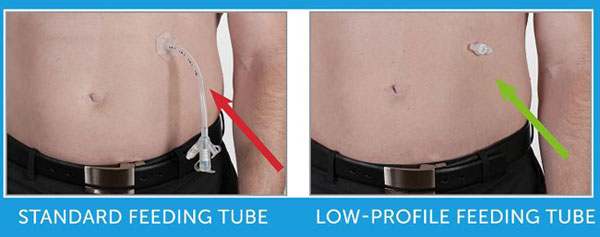
ALS Ice Bucket Challenge Progress

This content is sponsored by Halyard Health
As ALS progresses, some people may have difficulty reaching the caloric intake needed to maintain a healthy weight. If you are losing weight or struggling to eat, your doctor may recommend an enteral feeding tube to help you get the nutrients you need to maintain your weight and energy.
An enteral feeding tube is a medical device used for nourishment and hydration that is placed into the stomach or small intestine by a clinician. Enteral feeding tubes can also be used to administer medication, help increase fluid intake and to vent gases. For feeding, an extension tube is connected to a feeding bag or pump containing the nutrient formula prescribed. Some people feed via syringe, often called bolus feeding.
There are several different types of feeding tubes on the market. Most fall into two main categories based on the amount of tubing that hangs off the stomach—standard tubes and low-profile tubes. Standard tubes have tubing that extends about seven to eight inches from the stomach. This tubing can be cumbersome for patients when dressing and often needs to be taped down to be concealed under clothing.
Low-profile feeding tubes, such as Halyard Health’s MIC-KEY* Feeding Tubes, are another great option. As the name suggests, low-profile feeding tubes sit at skin level, which can make them easy to conceal. They are also less prone to dislodgement and the short internal length and diameter size makes problematic blockages less likely. The MIC-KEY* low-profile feeding tubes have the flexibility to be placed via a mature gastrostomy tract and are available as an initial placement option. Extension set tubing is attached to make feeding easier, and when not in use the port is covered with a cap to help prevent stomach contents from leaking.

Your clinician can help to determine the diet and feeding schedule that are right for you and best meet your nutritional needs, but you typically have a couple of different options when it comes to diet with feeding tubes. Some patients prefer a whole food, blenderized diet, while others use formulas.
The MIC-KEY* low-profile feeding tubes are easy to care for and require cleaning with soap and water, cotton-tip applicators, tissues and a syringe. It is important to keep the stoma, or area around where the feeding tube is inserted, clean and dry. You can do this by inspecting the skin before and after each feeding to check for any gastric leakage and prevent infection and granulation, which is the body’s attempt to repair the surgical incision.
Determining the right time to have a feeding tube placed is dependent upon several factors. Most patients only think about the need for a feeding tube when they begin to experience difficulty in swallowing. However, Dr. Kevin Friedman, Medical Director at Halyard Health, explains, “Early initial placement of feeding tubes is often recommended to reduce complications that can be associated with surgical placement in ALS patients. Early initial placement also gives people more time to get used to having a feeding tube.” Ultimately, you should consult with your clinician to decide when and if an enteral feeding tube is right for you.
To learn more about the benefits of low-profile feeding tubes and read about ALS patients using them, visit www.mic-key.com.